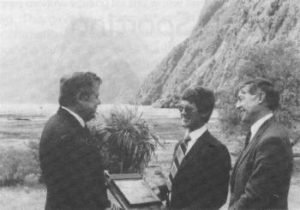- Author
- Bateman, Walter Samuel Grono, Commodore, RANR
- Subjects
- Biographies and personal histories, History - pre-Federation
- Tags
-
- RAN Ships
- HMAS Hobart II
- Publication
- June 1996 edition of the Naval Historical Review (all rights reserved)
The spectacular scenery of Fiordland on the south west coast of the South Island of New Zealand is well-known to cruise ship passengers and the ships’ companies of the occasional RAN ships visiting the area over the years, as well as to the hikers making the popular trek across the Milford Track to Milford Sound. What is less well known is that this area was first explored by the Sydney farmer, shipbuilder, sealer and former boatswain’s mate in the Royal Navy, Captain John Grono, who named many of the region’s significant physical features – Milford Sound. Mount Pembroke, Thompson Sound, Bligh Sound, Kndsor Point, Foveaux Strait, Cleddau River, and so on.
The Welsh derivation of many of these names in the Fordland of the South Island reflects Grono’s own origins in Wales. John Grono was born in 1767 at Pembroke on Milford Haven on the south west coast of Wales. Not much is known about his early life except that he joined the Royal Navy as a seaman, was wounded in 1794 while serving onboard HMS VENUS, and as a result was made a pensioner of the Naval Chest of Chatham at a yearly rate of five pounds. On the 20th July 1790, he married Elizabeth Bristow at Rotherhithe in London.
In 1798, Grono attained the rank of Boatswain’s Mate and later joined the armed stores ship, HMS BUFFALO, for a voyage to New South Wales. His position onboard the BUFFALO, which was also carrying a small number of free settlers, may well have been that of a supernumerary, for when the BUFFALO sailed from England, his wife Elizabeth, and two small daughters were also onboard. They arrived in Port Jackson on 3 May 1799.
As well as taking up a grant of land on the Hawkesbury, Grono was appointed mate of the Government-owned colonial schooner, FRANCIS, and held this position for five years until the FRANCIS was wrecked in 1805 at Newcastle. He then became master of the colonial sloop, SPEEDWELL, for a short time, but soon left the sea for a period to concentrate on farming and shipbuilding.
One of the ships built by Grono was the GOVERNOR BLIGH which he then commanded himself on many voyages to New Zealand between 1809 and 1819 for the purposes of sealing and exploring. He came to know almost every inch of the great, glacier-formed fjords of the South Island with their numerous arms and inlets penetrating deep into the Southern Alps. In November 1813, he rescued a party of Sydney sealers who had been stranded on Secretary Island between Doubtful Sound and Thompson Sound, a remote part of the Fiordland, for nearly four years, barely surviving on fish and seal meat.
Two of this party, Alexander Books and Robert McKenzie, were apparently so grateful to be rescued that they later married two of the daughters of John Grono!
Grono subsequently built and commanded the brig, ELIZABETH (named after his wife), which also made numerous sealing voyages to New Zealand and adjacent islands, as well as to Macquarie Island. Grono appears to have stopped seafaring himself in the mid 1820s but continued shipbuilding into the 1830s. Altogether he built twelve ships, the largest of which was the AUSTRALIAN, built in 1829, with a tonnage of 270 tons and a length of 100ft.

John Grono was my great-great-great grandfather. In October 1986, when in command of HMAS HOBART, I had the experience of visiting Milford Sound and retracing some of the movements of my ancestor. Onboard HOBART with me at the time was my cousin and another great-great-great grandson of John Grono’s, Captain Richard Grono. In tune with the Grono seafaring tradition, Richard was formerly a captain in the Australian merchant navy, spending time in command of the square-rigged ship, EYE OF THE WIND, and the Western Australian sail training vessel, LEEUWIN, of which he was the first master. Richard now teaches masters and mates at the Fremantle Technical College.





